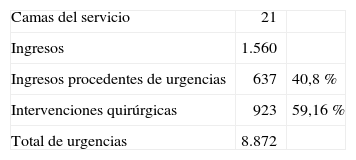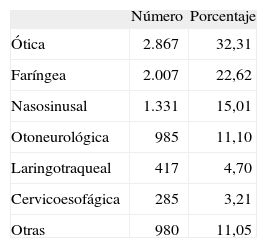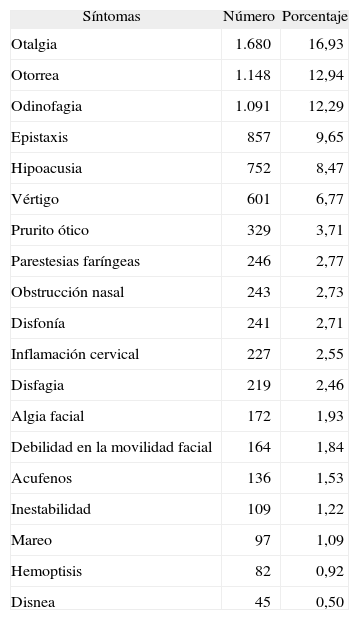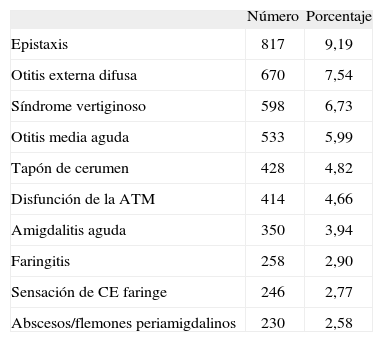La actividad asistencial en urgencias ha crecido de forma considerable en los últimos años. Probablemente, la inmigración y un incremento de la esperanza de vida han influido en este crecimiento. Muchos pacientes acuden buscando atención inmediata con tal de evitar listas de espera de especialidad en los centros de salud básicos. El principal objetivo es saber qué enfermedades en otorrinolaringología requieren asistencia médica urgente.
Material y métodosEs un estudio retrospectivo y descriptivo de 8.872 pacientes visitados en un año. Se analizaron algunas variables: edad, sexo, día de la semana, hora de llegada, destino final. Además, se hizo una distribución por categorías, dependiendo de la enfermedad presentada: otológica, rinológica, de faringe, laringe, cervical y otros.
ResultadosLa media diaria fue de alrededor de 25 pacientes por día. No hubo diferencias en cuanto al sexo. El lunes fue el día de la semana en el que se visitó a más pacientes. La enfermedad de oído fue la más atendida (32 %), seguida por la de faringe. De todas formas, la epistaxis (9,2 %) fue la entidad más común. El destino final en alrededor del 85 % fue el alta domiciliaria el mismo día.
ConclusionesEl aumento de demanda de la atención urgente en los hospitales debe analizarse de forma concienzuda porque puede ser aún peor, teniendo en cuenta las tendencias epidemiológicas. Deben proponerse diferentes focos y nuevas políticas en cuanto a las urgencias.
The number of patients attended in emergency rooms has gone up considerably in recent years. Immigration and an increase in life-expectancy have probably influenced this increase. A lot of patients come looking for immediate attention in order to avoid long waiting lists for specialist care at primary health-care facilities. The main objective is to know what pathologies in ear, nose and throat require urgent medical assistance.
Material and methodsThis is a retrospective descriptive study of 8,872 patients seen in a year. The variables analyzed were age, gender, day of the week, time of arrival, final result). In addition, a category distribution was made, depending on the pathology suffered: otological, rhinological, pharyngeal, laryngeal, cervical and others.
ResultsThe daily mean was about 25 patients per day. There were no differences in distribution by gender. Monday was the day of the week when more patients were seen. Otological pathologies represented the most frequent reason for attending (32 %), followed by pharyngeal emergencies. However, epistaxis (9.2 %) was the most common entity. The final outcome for about 85 % of the patients was discharge to home on the same day.
ConclusionsThe rising demand for emergency attention in hospitals must be meticulously analyzed because it might become even worse, taking epidemiological trends into account. Different foci and new policies regarding emergency centres should be proposed.
Artículo
Comprando el artículo el PDF del mismo podrá ser descargado
Precio 19,34 €
Comprar ahora











